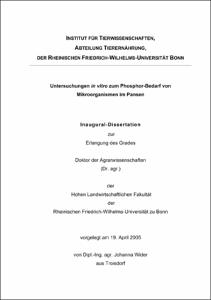Untersuchungen in vitro zum Phosphor-Bedarf von Mikroorganismen im Pansen

Untersuchungen in vitro zum Phosphor-Bedarf von Mikroorganismen im Pansen

| dc.contributor.advisor | Pfeffer, Ernst | |
| dc.contributor.author | Wider, Johanna | |
| dc.date.accessioned | 2020-04-07T15:44:55Z | |
| dc.date.available | 2020-04-07T15:44:55Z | |
| dc.date.issued | 2005 | |
| dc.identifier.uri | https://hdl.handle.net/20.500.11811/2179 | |
| dc.description.abstract | Es wurden drei Versuche durchgeführt mit dem Ziel der Ableitung des P-Bedarfs von Pansenmikroorganismen. In einem ersten Versuch wurden Bakterien aus flüssigem (LAB) und strukturiertem (SAB) Panseninhalt von Schafen isoliert. Die Bestimmung des N:P-Verhältnisses in LAB und SAB insgesamt und in deren Fraktionen Fett, Protein und Rest sollte Rückschlüsse auf den P-Nettobedarf der Pansenbakterien ermöglichen. Das N:P-Verhältnis lag bei den LAB bei 4,30 und bei den SAB bei 5,56. Daraus lässt sich ein P-Nettobedarf ableiten, der unter der Annahme eines mikrobiellen Proteinwachstums von 156 ± 24 g pro kg verdaulicher organischer Substanz (DOS; GfE 2003; 2001) auf 5,4 – 5,8 g/kg DOS für die LAB und 4,1-4,3 g/kg DOS für die SAB geschätzt wird. In den Fraktionen zeigte sich das weiteste N:P-Verhältnis in der Fraktion Protein (LAB 13,6; SAB 12,1). Das engste N:P-Verhältnis wurde in der Fraktion Rest bestimmt (LAB 0,55; SAB 0,83). In Versuch II und III wurde der P-Bedarf unter dynamischen Bedingungen für das mikrobielle Wachstum und die mikrobielle Fermentationsleistung untersucht. Im Langzeitinkubationssystem RUSITEC (Versuch II) leitete sich aus der Verwendung von Pufferlösungen mit unterschiedlichen Pa-Konzentrationen (zwischen 17,5 und 0 mmol Pa/L) ein P-Bedarf von kleiner 0,73 mmol Pa/L Fermenterinhalt ab. In Versuch III wurde mittels modifiziertem Hohenheimer Futterwerttests geprüft, ob der P-Bedarf für die mikrobielle Fermentationsleistung beim Abbau von Cellulose, Pektin oder Stärke nach 24 h unterschiedlich ist. Als Starterkultur diente der Überlauf eines RUSITEC-Versuches, der durch die Kombination mit Pufferlösungen unterschiedlicher Pa-Konzentrationen zu drei P-Stufen zwischen 3,84 und 0,90 mmol Pa/L Inkubationsgemisch führte. Die Synthese der VFA C2-C5 aus dem Abbau von Cellulose bzw. Pektin wurde bereits bei einer Pa-Konzentration von 2,29 mmol/L bzw. 0,90 mmol/L Inkubationsmedium eingeschränkt. Die Gasbildung wurde bei allen Futtermitteln bei einer P-Stufe von 0,90 mmol Pa/L reduziert. Damit ist anzunehmen, dass zum Abbau von Cellulose und Pektin eine höhere P-Versorgung notwendig ist. | en |
| dc.description.abstract | In vitro investigations on the Phosphorus requirements of rumen microorganisms Three experiments were conducted to estimate the Phosphorus (P) requirements of rumen microorganisms. In experiment I liquid (LAB) and solid (SAB) associated bacteria were isolated from the rumen of sheep. The N to P ratio of each of these microorganism types was determined and used to derive a daily P net requirement of 5,4 - 5,8 g P/kg digestible organic matter (DOS) for LAB and of 4,1 - 4,3 g P/kg DOS for SAB. This estimate is based on a production rate of 156 ± 24 g microbial protein (N*6,25) per kg of digestible organic matter (source: GfE 2003, 2001). Additional LAB and SAB were chemically separated into their fractions - lipids, protein and residuals - and the N to P ratio in the single fractions were analysed. The N to P ratio in the fraction protein was 13,6 for LAB and 12,1 for SAB, in the lipid fraction 1,09 for LAB and 1,55 for SAB and in the fraction residuals 0,55 and 0,83. It seems that the P containing compounds in LAB and SAB are different. The efficiency of fermentation and growth were used to estimate P requirements under dynamic conditions. In experiment II different P concentrations in the buffer solution of long term rumen simulation techniques (RUSITEC) resulted in a P requirement of < 0,73 mmol/L, whereas the microbial growth was estimated by the use of 15N as a marker. In experiment III a batch culture was used to asses if cellulolysis, amylolysis or pectinolysis require a different P supply. The overflow from RUSITEC were used as inoculum of Hohenheimer Futterwerttest (HFT). Cellulose, potato starch and pectin were used as substrates and incubated for 24 h. Three different P levels were testet (3,84 - 0,90 mmol Pa/L). Synthesis of volatile fatty acids (C2-C5) were reduced by lower P levels, but only after incubation of cellulose and pectin (cellulose 2,29 mmol/L; pectin 0,90 mmol/L). Incubation of starch had an adverse effect. Gas production after 24 h dropped down with a P supply of 0,90 mmol Pa/L, independent of substrate. It seems that the P requirements for cellulosysis and pectinolysis are higher than for the degradation of starch. | en |
| dc.language.iso | deu | |
| dc.rights | In Copyright | |
| dc.rights.uri | http://rightsstatements.org/vocab/InC/1.0/ | |
| dc.subject | Pansen | |
| dc.subject | Mikroorganismen | |
| dc.subject | Phosphor | |
| dc.subject | Fermentation | |
| dc.subject | RUSITEC | |
| dc.subject | rumen | |
| dc.subject | microorganisms | |
| dc.subject | phosphorus | |
| dc.subject.ddc | 630 Landwirtschaft, Veterinärmedizin | |
| dc.title | Untersuchungen in vitro zum Phosphor-Bedarf von Mikroorganismen im Pansen | |
| dc.type | Dissertation oder Habilitation | |
| dc.publisher.name | Universitäts- und Landesbibliothek Bonn | |
| dc.publisher.location | Bonn | |
| dc.rights.accessRights | openAccess | |
| dc.identifier.urn | https://nbn-resolving.org/urn:nbn:de:hbz:5N-05355 | |
| ulbbn.pubtype | Erstveröffentlichung | |
| ulbbnediss.affiliation.name | Rheinische Friedrich-Wilhelms-Universität Bonn | |
| ulbbnediss.affiliation.location | Bonn | |
| ulbbnediss.thesis.level | Dissertation | |
| ulbbnediss.dissID | 535 | |
| ulbbnediss.date.accepted | 23.05.2005 | |
| ulbbnediss.institute | Landwirtschaftliche Fakultät : Institut für Tiererwissenschaften | |
| ulbbnediss.fakultaet | Landwirtschaftliche Fakultät | |
| dc.contributor.coReferee | Schellander, Karl |
Files in this item
This item appears in the following Collection(s)
-
E-Dissertationen (1107)




